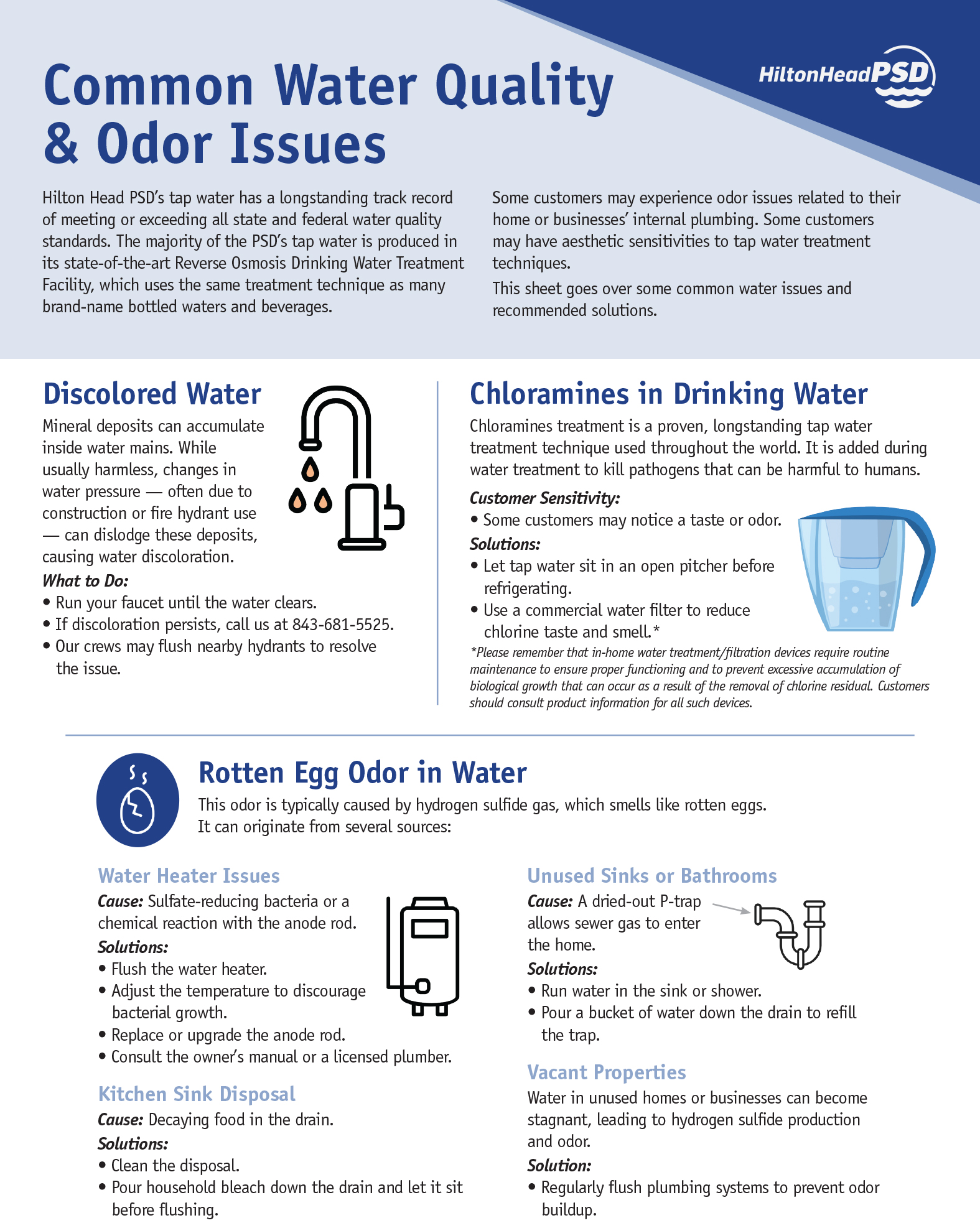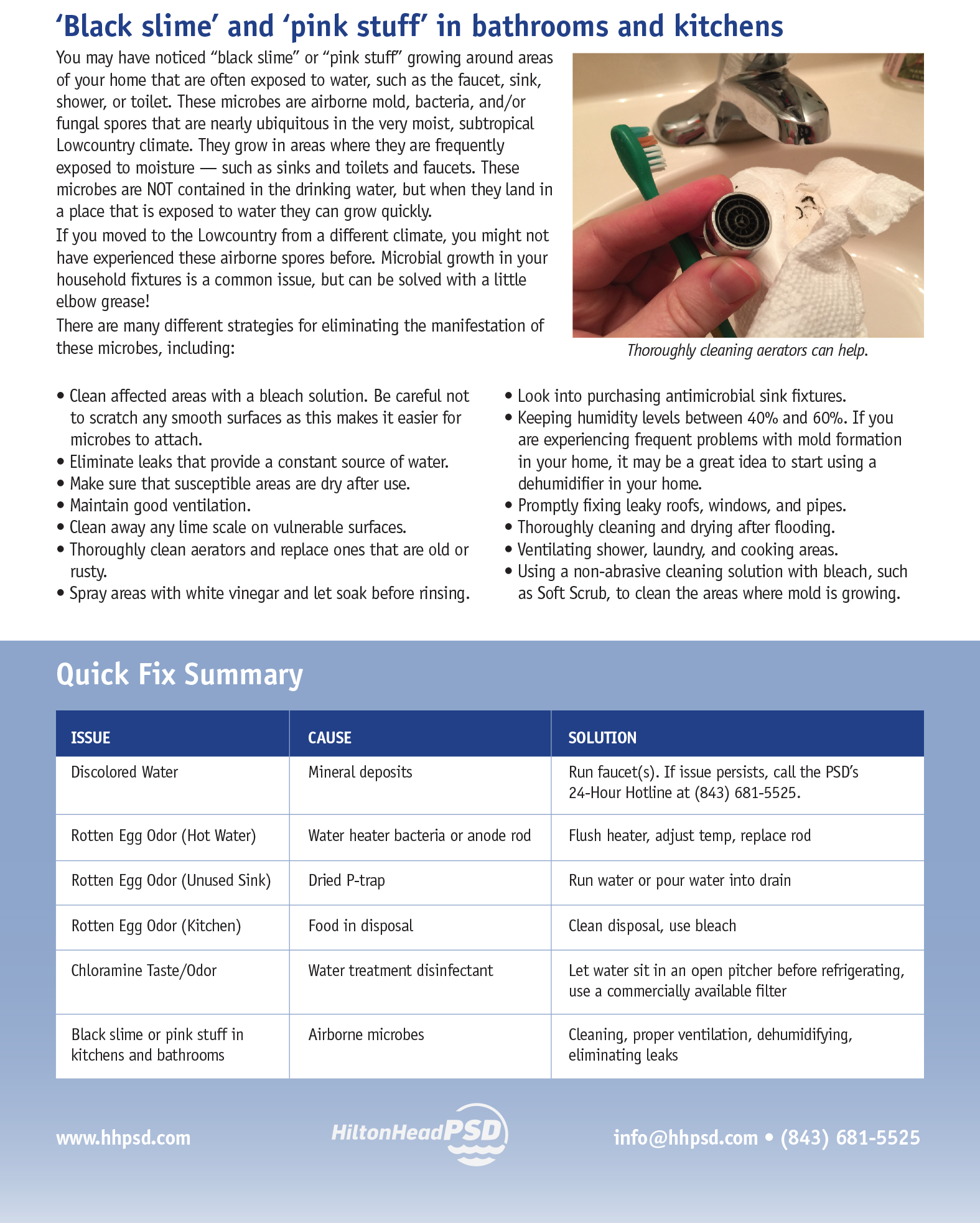Hilton Head PSD’s tap water has a longstanding track record of meeting or exceeding all state and federal water quality standards. The majority of the PSD’s tap water is produced in its state-of-the-art Reverse Osmosis Drinking Water Treatment Facility, which uses the same treatment technique as many brand-name bottled waters and beverages.
Some customers may experience odor issues related to their home or businesses’ internal plumbing. Some customers may have aesthetic sensitivities to tap water treatment techniques. Below are some common issues and recommended solutions.
Discolored Water
Mineral deposits can accumulate inside water mains. While usually harmless, changes in water pressure—often due to construction or fire hydrant use—can dislodge these deposits, causing water discoloration.
What to Do:
- Run your faucet until the water clears.
- If discoloration persists, call us at 843-681-5525.
- Our crews may flush nearby hydrants to resolve the issue.
Rotten Egg Odor in Water
This odor is typically caused by hydrogen sulfide gas, which smells like rotten eggs. It can originate from several sources:
Water Heater Issues
Cause: Sulfate-reducing bacteria or a chemical reaction with the anode rod.
Solutions:
- Flush the water heater.
- Adjust the temperature to discourage bacterial growth.
- Replace or upgrade the anode rod.
- Consult the owner’s manual or a licensed plumber.
Unused Sinks or Bathrooms
Cause: A dried-out P-trap allows sewer gas to enter the home.
Solutions:
- Run water in the sink or shower.
- Pour a bucket of water down the drain to refill the trap.
Kitchen Sink Disposal
Cause: Decaying food in the drain.
Solutions:
- Clean the disposal.
- Pour household bleach down the drain and let it sit before flushing.
Vacant Properties
Water in unused homes or businesses can become stagnant, leading to hydrogen sulfide production and odor.
Solution:
- Regularly flush plumbing systems to prevent odor buildup.
Chloramines in Drinking Water
Chloramines treatment is a proven, longstanding tap water treatment technique used throughout the world. It is added during water treatment to kill pathogens that can be harmful to humans.
Customer Sensitivity:
- Some customers may notice a taste or odor.
Solutions:
- Let tap water sit in an open pitcher before refrigerating.
- Use a commercial water filter to reduce chlorine taste and smell. *
*Please remember that in-home water treatment/filtration devices require routine
maintenance to ensure proper functioning and to prevent excessive accumulation of
biological growth that can occur as a result of the removal of chlorine residual.
Customers should consult product information for all such devices.
‘Black slime’ and ‘pink stuff’ in bathrooms and kitchens
You may have noticed “black slime” or “pink stuff” growing around areas of your home that are often
exposed to water, such as the faucet, sink, shower, or toilet. These microbes are airborne mold, bacteria,
and/or fungal spores that are nearly ubiquitous in the very moist, subtropical Lowcountry climate. They
grow in areas where they are frequently exposed to moisture – such as sinks and toilets and faucets.
These microbes are NOT contained in the drinking water, but when they land in a place that is
exposed to water they can grow quickly. If you moved to the Lowcountry from a different climate, you
might not have experienced these airborne spores before. Microbial growth in your household fixtures is
a common issue, but can be solved with a little elbow grease!
There are many different strategies for eliminating the manifestation of these microbes, including:
- Clean affected areas with a bleach solution. Be careful not to scratch any smooth surfaces as this makes it easier for microbes to attach.
- Eliminate leaks that provide a constant source of water.
- Make sure that susceptible areas are dry after use.
- Maintain good ventilation.
- Clean away any lime scale on vulnerable surfaces.
- Thoroughly clean aerators and replace ones that are old or rusty.
- Spray areas with white vinegar and let soak before rinsing.
- Look into purchasing antimicrobial sink fixtures.
- Keeping humidity levels between 40% and 60%. If you are experiencing frequent problems with
mold formation in your home, it may be a great idea to start using a dehumidifier in your home.
- Promptly fixing leaky roofs, windows, and pipes;
- Thoroughly cleaning and drying after flooding;
- Ventilating shower, laundry, and cooking areas;
- Using a non-abrasive cleaning solution with bleach, such as Soft Scrub, to clean the areas where mold is growing.
Quick Fix Summary
| Issue | Cause | Solution |
| Discolored Water | Mineral deposits | Run faucet(s). If issue persists, call PSD 24-Hour Hotline at (843) 681-5525. |
| Rotten Egg Odor (Hot Water) | Water heater bacteria or anode rod | Flush heater, adjust temp, replace rod |
| Rotten Egg Odor (Unused Sink) | Dried P-trap | Run water or pour water into drain |
| Rotten Egg Odor (Kitchen) | Food in disposal | Clean disposal, use bleach |
| Chloramine Taste/Odor | Water treatment disinfectant | Let water sit in an open pitcher before refrigerating, use a commercially available filter |
| Black slime or pink stuff in kitchens and bathrooms | Airborne microbes | Cleaning, proper ventilation, dehumidifying, eliminating leaks |
2025




